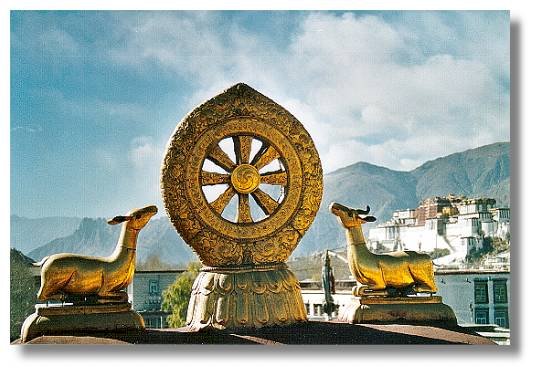|
Tibetan Spaniel
|
|
The Tibetan Spaniel is an intelligent little dog, who finds his origin in the mountains of Tibet. They found their homes in Tibetian monasteries, and their were highly respected by the priests who took care of them. The bark of the Tibetan Spaniel would alert the monks for approaching visitors.
This characteristic can still be found in the breed, as Tibetan Spaniels alert their owners when anything strange occurs around the house. Just like in times far gone, Tibetan Spaniels still like to find a place which gives them the opportunity to keep an eye on their surroundings. Tibetan Spaniels are not real guard dogs, as they do not show signs of aggression. They can be a bit aloof towards strangers, but this usually passes once they get to know someone. The breed is fairly healthy, and Tibetan Spaniels can reach an age of approximately 15 to 16 years. They are lively, and playful, and sometimes very curious. They can reach a hight of about 25 cm, and their weight varies between the 4 and 6,5 kg. The Tibetan Spaniel has got a silk-like, double long-haired coat. All colors are permitted, but the most common color is gold. The coat is lown maintenance, and requires an occassional combing.
Tibetan Spaniels are smart and are easy to train; but one needs to be consistent as the breed is known to be stubborn. Their are good with children and other pets. Tibetan Spaniels don't require much excercise, just the usual walks and enough room to play and run.
Breedstandard
FCI-Standard N° 231 / 11. 05. 1998 / GB PATRONAGE : Great Britain. DATE OF PUBLICATION OF THE ORIGINAL VALID STANDARD : 24.06.1987. UTILIZATION : Companion Dog.
CLASSIFICATION F.C.I. : Group9 Companion and Toy Dogs. GENERAL APPEARANCE : Small, active and alert. Well balanced in general outline, slightly longer in body than height at withers. BEHAVIOUR / TEMPERAMENT : Gay and assertive, highly intelligent, aloof with strangers. Alert, loyal but independant. HEAD : Small in proportion to body, carried proudly. Masculine in dogs but free from coarseness.
CRANIAL REGION :
FACIAL REGION : NECK : Moderately short, strong and well set on. Covered with a mane or " shawl " of longer hair, more pronounced in dogs than bitches.
BODY : Slightly longer from withers to root of tail than the height at
withers. TAIL : Set high, richly plumed and carried in a gay curl or over back when moving. (Not to be penalised for drooping tail when standing). LIMBS
FOREQUARTERS : Moderate bone; forelegs slightly bowed but firm at shoulder.
HINDQUARTERS : Well made and strong.
FEET : Harefoot. Small and neat with feathering between toes often extending
beyond the feet. Round cat-feet undesirable. COAT HAIR : Topcoat silky in texture, smooth on face and front of legs, of moderate length on body, but lying rather flat. Undercoat fine and dense. Ears and back of forelegs nicely feathered, tail and buttocks well furnished with longer hair. Not overcoated, bitches tend to carry less coat and mane than dogs. COLOUR : All colours and mixture of colours permissible.
SIZE AND WEIGHT : Height about 25.4 cm (10 ins). FAULTS : Any departure from the foregoing points should be considered a fault and the seriousness with which the fault should be regarded should be in exact proportion to its degree and its effect upon the health and welfare of the dog. Any dog clearly showing physical or behavioural abnormalities shall be disqualified. N.B. : Male animals should have two apparently normal testicles fully descended into the scrotum.
|


